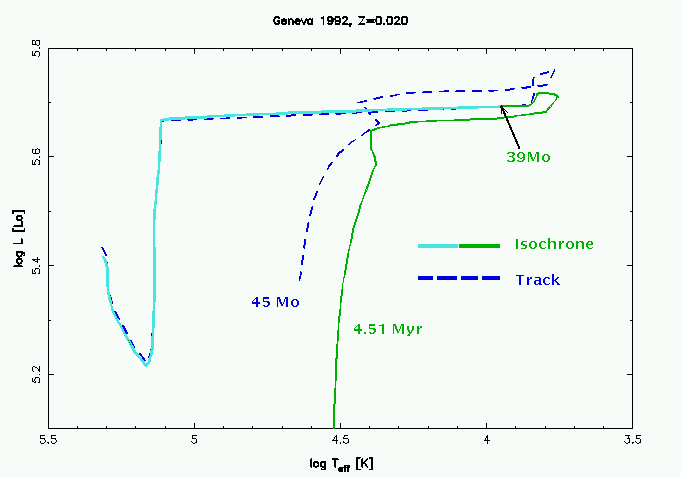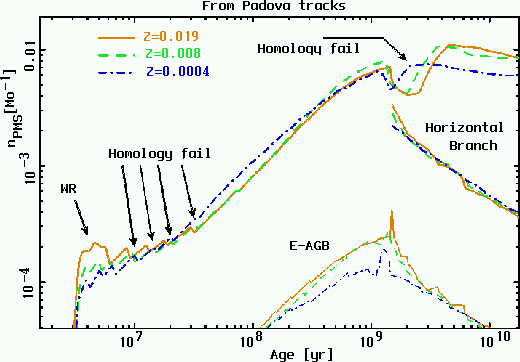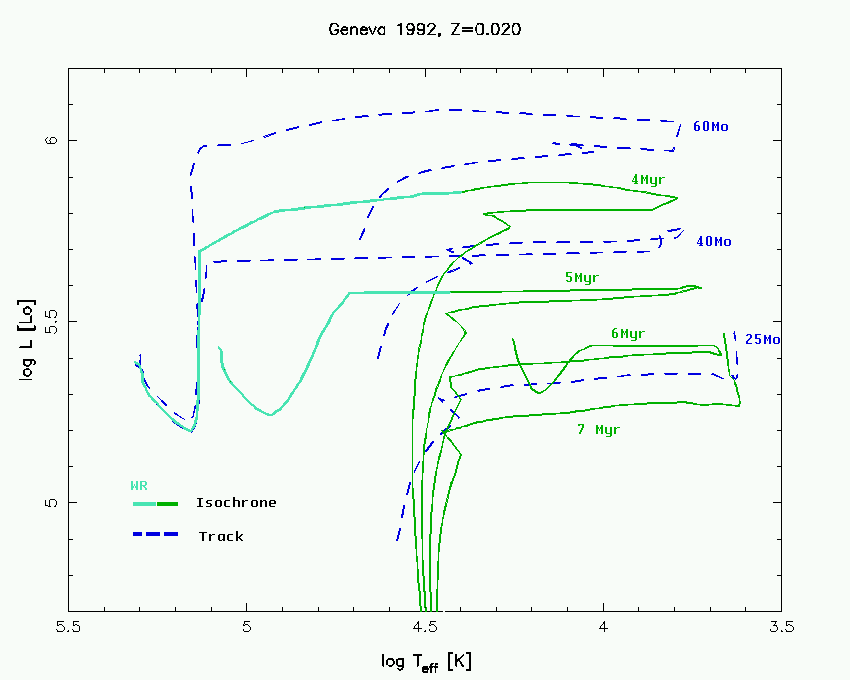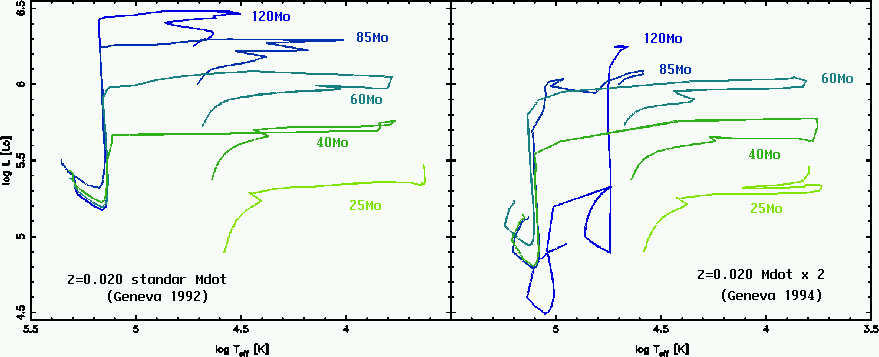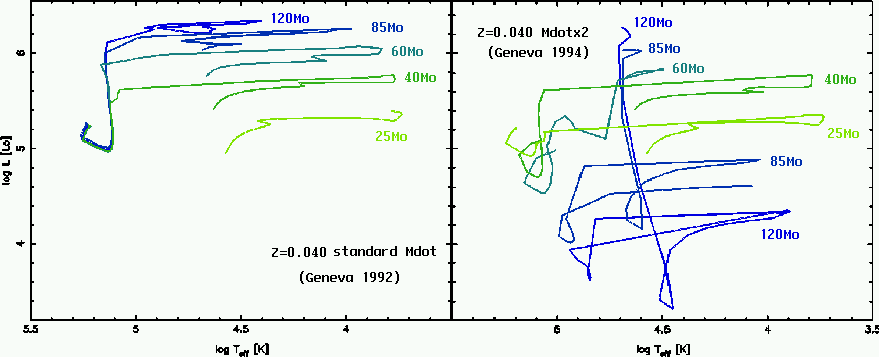Let's began in the way how the isocrones are computed. The basic idea was
quoted in:
The Astrophysical Journal, 203: 52-62, 1976 January 1
Evolutionary Synthesis of Stellar Population in Elliptical
Galaxies I. Ingredients, Broad-Band Colors, and Infrared Features
Beatrice M. Tinsley
James E. Gunn
In Section II. Stellar Ingredients, subsection b) Evolving Dwarfs and Subgiants
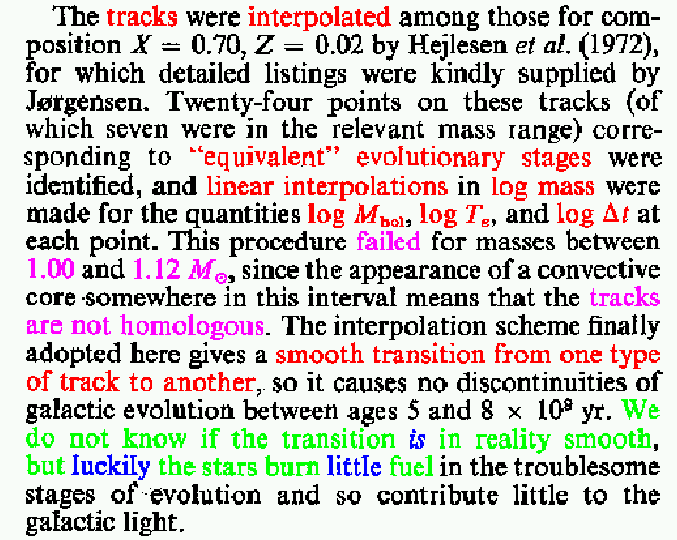
In this paper it is shown the first problem to obtain isochrones: the
definition of equivalent evolutionary points
and the use of homology relations. Some
usefull references for understand what homology means are:
In sumary, an homology transformation gives us a scale relation of a
property x of a star (L, Teff, R,  ms) with their Mass, M, mean molecular weight,
ms) with their Mass, M, mean molecular weight,  , nuclear energy
production,
, nuclear energy
production,  , opacity coefficient,
, opacity coefficient,  , and Hydrogen abundance in
the core, X, for the same
configuration. As an example, for the CNO burning in the Main sequence, Kramers opacity law and radiatie
transport configuration the relations are:
, and Hydrogen abundance in
the core, X, for the same
configuration. As an example, for the CNO burning in the Main sequence, Kramers opacity law and radiatie
transport configuration the relations are:

Other configurations means, mainly, a changue in the exponents. These
relations, together with  , allow us to define equivalent evolutionary points:
points where
, allow us to define equivalent evolutionary points:
points where  ,
,  (structure) and
(structure) and  , and X (burning state) have the same
value. So, for these reasons,
, and X (burning state) have the same
value. So, for these reasons,
- Tracks are tabulated following the
abundance of the central burning element (H, He, C)
- Interpolations must be done in the log M - log x plane.
(Un)fortunatelly, this simple squeme is not valid for all the mass range
because the internal structure of the star changues. Additionally, the
homology relations are a good aproximation only for
Main sequence stars. Then, for these reasons there are tracks with
different initial masses and not only an individual track.
However, it is assumed to be a good
aproximation for all the evolutionary stages (it is the most simple
assumption and it is in fact implicit in all the synthesis codes, as far as
I know). It woul be valid if
- The stellar tracks are close enough in
the HR diagram.
- There is no discontinuities in the
stellar evolution.
i.e. when adyacent tracks
``resemble'' each other
However. since the evolution of Post Main Sequence
Stars (PMS) are quite important in the integrated ligth of an stellar
cluster, there are additional ways to compute the PMS evolution.
- Obtain directly the isochrone from interpolations of the tracks (as I
explained before). This is the most usual in models for star forming
regions:
- Adventages: It obtain easily the properties
of individual stars; i.e. for each star in the isochrone, their physical
properties are known and the integration with the IMF are quite easy.
- Disadventages:
It does not asure that the
mathematical interpolations reproduce a real physical situation: i.e. some
of the stars in the isochrone may not be physicaly consitent. As example:
- There are no homology relations for compute mass lost rates.
- There are no hology relations for compute the surface abundances (needed
for obtain the WR population and for the ejection rates of massive stars
for chemical evolution models).
- Internal structure (and lifetimes) changue with mass lost
(i.e. homology relations fails).
- Use the Post-Main Sequence part of the Isocrhone from stellar tracks of individual stars:
- Adventages: The isochrone is physically
self-consistent.
- Disadventages: It is needed aditional
assumptions to populate the isochrone, like the Fuel
Comsumption Theorem (Buzzoni
1989, ApJS 71, 817).
Theoretically both methods should be equivalent, as the next Figure
shows. Even more, it can be demostrated that there are a critical mass
point in the isochrone where the following points in the isochrone
coincides with the track of an individual star.


